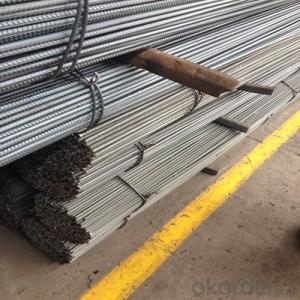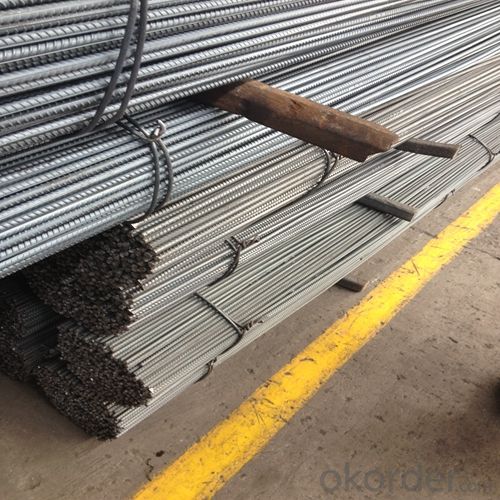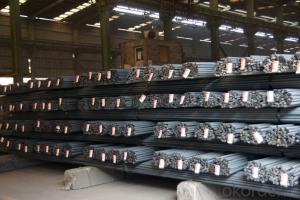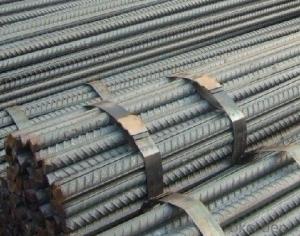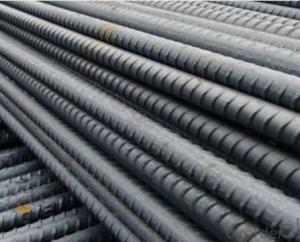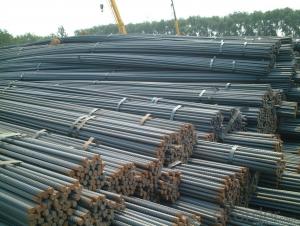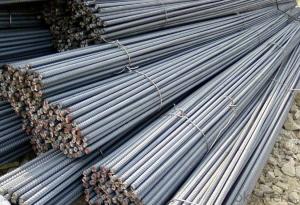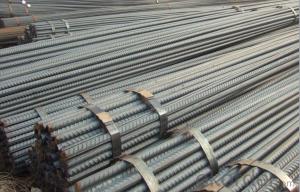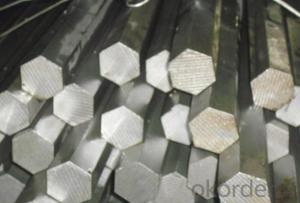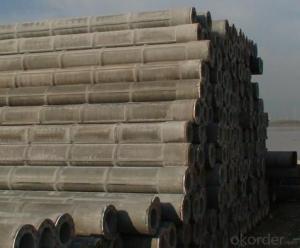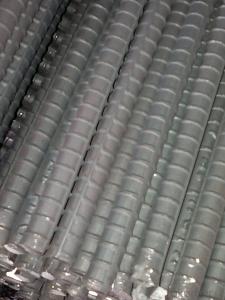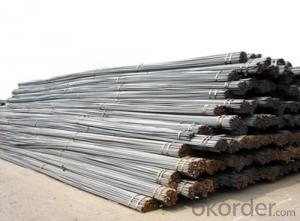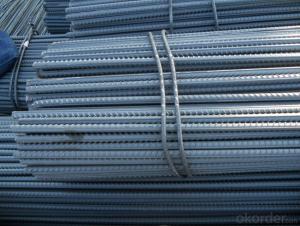Hot Rolled Steel Rebar Deformed Bar High Quality
- Loading Port:
- Tianjin
- Payment Terms:
- TT OR LC
- Min Order Qty:
- 1000 m.t.
- Supply Capability:
- 30000 m.t./month
OKorder Service Pledge
OKorder Financial Service
You Might Also Like
Product Description:
Quick Details
Standard:AISI, ASTM, BS, DIN, GB, JIS
Grade:HRB335
Diameter:10mm-40mm
Length:Normally 6~12m
Place of Origin:Fujian, China (Mainland)
Model Number:QZMM-ST001
Application:Building material, construction, road, bridge,etc
Product Name:Steel Rebars,Deformed Steel Bars,Building Material China Manufacturer
Standard:ASTM A615 /BS BS 4449 /GB HRB/ JIS G3112
Material:HRB335
Shape:Straight reinforcing bars
Technique:Low temperature hot-rolling reinforcing deformed steel rebar
Tolerance:As the standard or as your requirement
MOQ:100tons per size steel rebar
Packing details Steel:Steel rebar packed in bundle or as your requirement
Delivery:Within 30 days after deposit
Post:XIAMEN,CHINA
Packaging & Delivery
| Packaging Details: | in bundles or as customer's requirement |
|---|---|
| Delivery Detail: | Within 30days after receiving your deposit or copy of L/C |
Product Description
| Name | Steel Rebars,Deformed Steel Bars,Building Material China Manufacturer |
| Standard | ASTM A615 /BS BS 4449 /GB HRB/ JIS G3112 |
| Grade | A615 Gr40/60/75 BS 4449 Gr460,B500 GB HRB335(E) JIS G3112 SD390 |
| Diameter | 10mm-40mm |
| Length | 6-12m |
| Technique | Low temperature hot-rolling reinforcing deformed steel rebar |
| Tolerance | As the standard or as your requirement |
| Application | Building, construction, road, bridge,etc |
| Certificated | BV |
| MOQ | 100tons per size steel rebar |
| Packing details | Steel rebar packed in bundle or as your requirement |
| Delivery | Within 30 days after deposit |
| Payment | T/T or L/C |
Chemical Composition
Grade | Technical data of the original chemical composition (%) | |||||||
C | Mn | Si | S | P | B | |||
HRB335 | ≤0.25 | ≤1.60 | ≤0.80 | ≤0.045 | ≤0.045 | >0.0008 | ||
Physics capability | ||||||||
Yield Strength(N/cm2) | Tensile Strength(N/cm2) | Elongation (%) | ||||||
≥335 | ≥490 | ≥16 | ||||||
Grade | Technical data of the original chemical composition (%) | |||||||
C | Mn | Si | S | P | V | |||
HRB400 | ≤0.25 | ≤1.60 | ≤0.80 | ≤0.045 | ≤0.045 | 0.04-0.12 | ||
Physics capability | ||||||||
Yield Strength(N/cm2) | Tensile Strength(N/cm2) | Elongation (%) | ||||||
≥400 | ≥570 | ≥14 | ||||||
Usage and Applications of HRB400 Deformed Steel Bar:
Deformed bar is widely used in buildings, bridges, roads and other engineering construction. Big to highways, railways, bridges, culverts, tunnels, public facilities such as flood control, dam, small to housing construction, beam, column, wall and the foundation of the plate, deformed bar is an integral structure material. With the development of world economy and the vigorous development of infrastructure construction, real estate, the demand for deformed bar will be larger and larger..
Packaging & Delivery of HRB400 Deformed Steel Bar:
Packaging Detail: products are packed in bundle and then shipped by container or bulk vessel, deformed bar is usually naked strapping delivery, when storing, please pay attention to moisture proof. The performance of rust will produce adverse effect.
Each bundle weight: 2-3MT, or as required
Payment term: TT or L/C
Delivery Detail: within 45 days after received advanced payment or LC.
Label: to be specified by customer, generally, each bundle has 1-2 labels
Trade terms: FOB, CFR, CIF
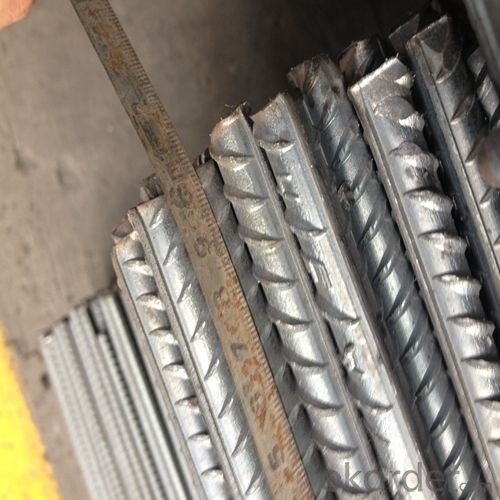
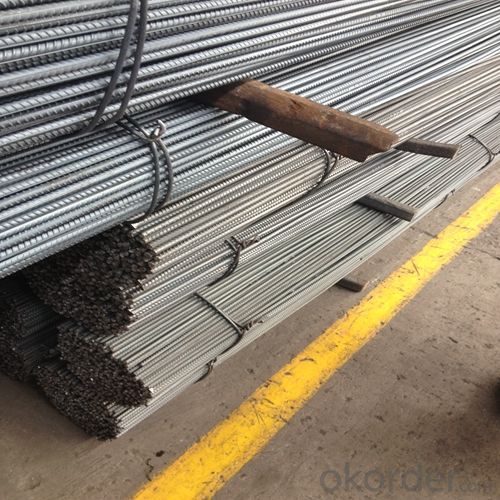
- Q: How do steel rebars affect the overall crack resistance of concrete structures?
- Steel rebars significantly improve the crack resistance of concrete structures. By reinforcing the concrete, rebars help distribute and absorb tensile forces, preventing the formation and propagation of cracks. This reinforcement enhances the overall strength and durability of the concrete, making the structure more resistant to cracking under various loads and environmental conditions.
- Q: What are the different methods for attaching steel rebars to existing structures?
- There are several methods for attaching steel rebars to existing structures, including drilling and epoxy anchoring, mechanical anchoring using couplers, welding, and using adhesive or resin-based systems. Each method has its own advantages and considerations depending on the specific requirements and conditions of the structure.
- Q: How do steel rebars affect the crack resistance of concrete structures?
- Steel rebars significantly increase the crack resistance of concrete structures. By reinforcing the concrete, rebars help distribute the tensile forces that cause cracking, improving the overall strength and durability of the structure. The rebars act as a reinforcement to hold the concrete together and prevent cracks from forming or spreading, ensuring the longevity and structural integrity of the construction.
- Q: How are steel rebars stored on-site?
- Steel rebars are typically stored on-site in designated areas that are specifically designed for rebar storage. These areas are usually flat and well-drained, ensuring that the rebars remain clean and free from rust or damage. The rebars are often stacked horizontally, with spacers placed between each layer to maintain proper alignment and prevent tangling. Additionally, rebars may be covered with tarps or plastic sheets to protect them from moisture and other environmental factors. Overall, proper storage of steel rebars on-site is crucial to maintain their quality and ensure their structural integrity.
- Q: Can the thread steel of the steel platform of the fixed unloading platform not work?
- The cantilever beam end should set the wire rope or steel rod with a layer of building structure of cable-stayed suspension type steel each node. The rings of wire rope and building structure Rachel should use HPB300 grade steel, its diameter should not be less than 22mm, the rings embedded anchor reinforcement anchorage length should be specified in accordance with current national standard "code for design of concrete structures" in GB50010.
- Q: What is the role of steel rebars in bridge construction?
- The role of steel rebars in bridge construction is to provide reinforcement and strength to the concrete structure. Rebars are embedded within the concrete to enhance its ability to withstand tension forces, increase durability, and prevent cracking or failure. They help distribute the load across the bridge, ensuring its stability and longevity.
- Q: What is the minimum cover required for steel rebars in concrete?
- The minimum cover required for steel rebars in concrete typically depends on the specific project's design and local building codes. However, a general guideline is that the minimum cover should be at least 1.5 inches (38 mm) for rebars in exposed conditions and 3/4 inch (19 mm) for rebars in non-exposed conditions. It is essential to consult the project's structural engineer or refer to the local building codes for the precise minimum cover requirements.
- Q: Can steel rebars be used in foundation reinforcement?
- Yes, steel rebars can be used in foundation reinforcement. They are commonly used to provide strength and stability to concrete foundations by adding reinforcement and preventing cracks or structural failures.
- Q: Are steel rebars subject to any international standards or regulations?
- Yes, steel rebars are subject to international standards and regulations. The most widely recognized international standard for steel rebars is the ISO 6935-2 standard, which sets requirements for the chemical composition, mechanical properties, and dimensions of rebars. Additionally, various countries have their own national standards and regulations that ensure the quality and safety of steel rebars used in construction projects.
- Q: What is a steel rebar?
- A steel rebar is a commonly used construction material that consists of a steel rod or bar with ribbed patterns. It is primarily used to reinforce concrete structures, providing strength and stability to the overall construction.
Send your message to us
Hot Rolled Steel Rebar Deformed Bar High Quality
- Loading Port:
- Tianjin
- Payment Terms:
- TT OR LC
- Min Order Qty:
- 1000 m.t.
- Supply Capability:
- 30000 m.t./month
OKorder Service Pledge
OKorder Financial Service
Similar products
Hot products
Hot Searches
Related keywords
